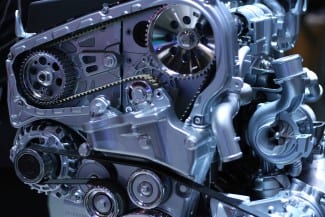Electric Vehicle Technology R&D Opportunities

The automotive industry is preparing for a future where consumers can purchase a wide range of powertrain types. Although internal combustion engines (ICEs) will continue to represent a large portion of the market, battery electric and hybrid options will grow in popularity and become a much more widespread option. OEMs are preparing for this reality but have recently begun to focus their investments into a narrower selection of offerings.
Automotive manufacturers, including supplier and technology developers, should take a similar approach and identify a set of technologies they wish to advance.
Electric and hybrid vehicle technologies will require significant investment over the coming years to make switching from ICEs an even more attractive option. This includes performing innovative research and development projects to improve energy storage systems, electric motors, power electronics, and vehicle charging infrastructure. Suppliers and technology developers that can supply components delivering reliability and value in these areas will be poised for long-term success, which makes this an opportunity that should not be overlooked.
Hybrid and EV Energy Storage Systems
Nearly one in five automotive executives surveyed by KPMG in 2019 identified that the one thing keeping them away from purchasing an electric vehicle is range. Range – how far the vehicle can travel on a single battery charge – remains a critical factor in the minds of many when purchasing vehicles and requires several more technological breakthroughs before pure battery electric vehicles are ready for mass adoption. Range is a primary reason why the automotive market will still look to hybrid systems well into the future, since having an additional fuel source reduces fear of being stranded without the ability to refuel.
Demand for extended-range battery electric storage systems will intensify as more consumers look to purchase innovative vehicles. Manufacturers are required to design and develop these systems.
In the coming years, materials used to construct vehicle batteries will improve. Second and third generation lithium ion batteries will provide higher voltage and capacity, therefore offering better power and range. While the timeline for such advancements is unclear, it’s possible that automotive manufacturers will move beyond lithium ion batteries to newer, more innovative materials (such as solid-state lithium metal, lithium air, zinc air, and magnesium ion) that deliver the performance characteristics most drivers seek in their vehicles.
Electric Vehicle Motor Systems
 Like batteries and storage systems, electric motors will also play a significant role in the transition to EVs. Ensuring drivers can get the best performance out of their vehicles and don’t feel restricted in comparison to internal combustion engines is an important factor when convincing consumers to switch to, and stay with, electric powertrains. The size and number of electric motors, their material composition, and placement in the vehicle all need to be considered.
Like batteries and storage systems, electric motors will also play a significant role in the transition to EVs. Ensuring drivers can get the best performance out of their vehicles and don’t feel restricted in comparison to internal combustion engines is an important factor when convincing consumers to switch to, and stay with, electric powertrains. The size and number of electric motors, their material composition, and placement in the vehicle all need to be considered.
Developing motor systems that offer comparable performance to combustion engines while minimizing energy requirements is a central focus of electric vehicle manufacturers.
While electric motors might not be as commonly discussed as battery systems, they nonetheless have significant implications that are integral to greater adoption of electric powertrains. OEMs tend to be the biggest developers of these technologies and have not communicated the science behind them well, which had led to fewer consumers understanding or feeling optimistic about electric motors. As EV motor systems become a larger focus and more technology developers innovate them, it will help drive demand for electric vehicle models.
EV Power Electronics Systems
Most common in hybrid-electric vehicles, power electronics systems are designed to enable the shifting between fuel sources. A generator, charger, and converter are the components often needed to make these systems work and can improve electric vehicle efficiency by charging hybrid electric batteries while other, non-electric fuel sources like gasoline or hydrogen power the engine.
Providing a critical link between traditional fossil fuels and electric sources of power, hybrid vehicles and their systems are an ideal focus for automotive innovators.
Over 10% of automotive executives report they would not purchase an electric vehicle because it might not be suitable for daily use. Hybrid technologies and diversification of vehicle power sources can help overcome this fear and lead to more traditional vehicle owners beginning the transition to electric powertrains. Automotive suppliers can develop components that lead to optimized power generation, conversion, and utilization to profit from the hybridization trend.
Electric Vehicle Charging Infrastructure
 Electric charging infrastructure is an incredibly important factor used to consider which type of powertrain to develop or purchase. Currently, most charging stations are home-based and use solar power or plug into electrical outlets to convert energy for vehicle batteries. This convenience is a benefit to most electric vehicle owners, although if concerns persist about vehicle range, many consumers will fear that they could become stranded without the ability to recharge.
Electric charging infrastructure is an incredibly important factor used to consider which type of powertrain to develop or purchase. Currently, most charging stations are home-based and use solar power or plug into electrical outlets to convert energy for vehicle batteries. This convenience is a benefit to most electric vehicle owners, although if concerns persist about vehicle range, many consumers will fear that they could become stranded without the ability to recharge.
Investments into public charging infrastructure will be just as important as private, home-based charging structure over the coming years.
Improving the recharge rate of electric and hybrid vehicles will be a major step to ensuing owners maximize their range. While basic (Level 1) chargers can fully charge vehicles in about 8-12 hours, more Level 2-3 chargers (charging vehicles in about 1-6 hours) will need to be produced at lower prices than currently offered. When this happens, more public and private purchasers will invest in EV charging technologies and they will become increasingly available. Giving consumers the freedom to recharge in a wide variety of locations – and supporting faster recharge rates – is key to having more consumers purchase electric vehicles.
Resources to Research and Develop Electric Vehicle Technology
Canadian innovators have a wealth of resources available to support the development of electric vehicle technologies. Not only are there networks of likeminded automotive suppliers and innovators to join and accelerate innovations with, but there’s also Canadian government funding programs available to reduce research and development costs.
To learn more about resources that can fuel the growth of automotive and technology businesses, please download Mentor Works’ Electric and Autonomous Vehicle Trends white paper.

